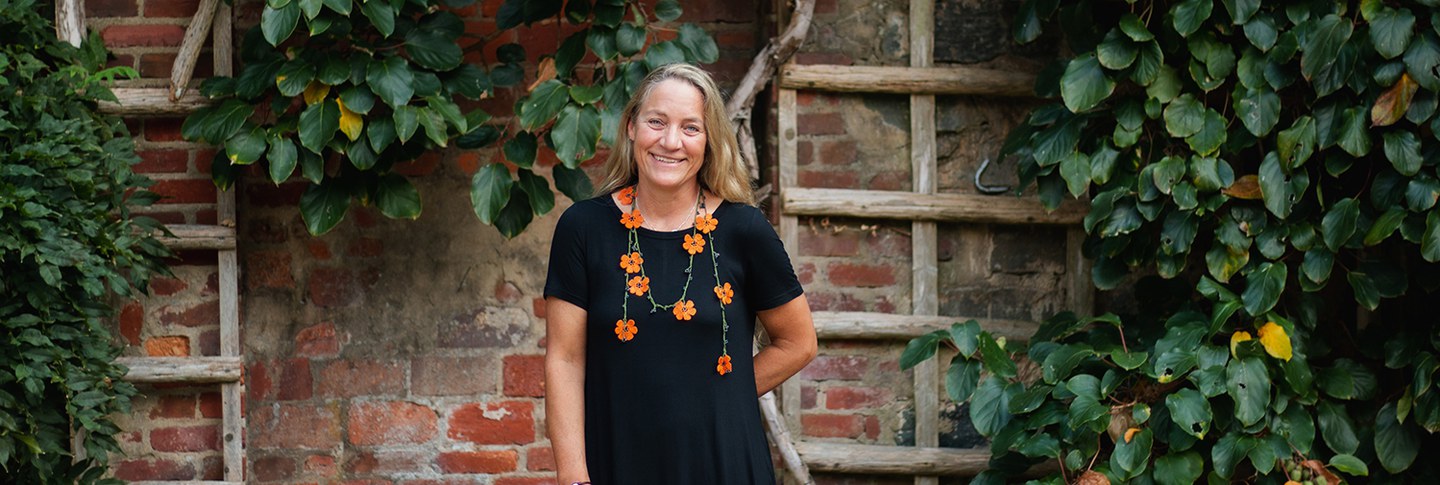Annette Giesecke, Elias Ajuha Professor of Classics at the University of Delaware, is a fellow in Garden and Landscape Studies. Her recent research report, “The Afterlife of Paradise: Near Eastern Origins of the Ancient Roman Garden,” presented links between Cyrus the Great’s royal Persian garden city at Pasargadae, Iran, and Roman domestic gardens in terms both of form and meaning.
Q&A with Annette Giesecke
What changed in the Roman garden around 200 BCE?
A remarkable change occurred in the design of Roman houses and their gardens at that time. Gardens generally shifted from a subsidiary position to a prominent one, visible from the main rooms, a centerpiece of life, a showcase. And what were once solely kitchen gardens became ornamental, containing native and exotic plants that were both decorative and useful. This was very different from houses in classical Greece, which, on the surface, appear similar, but where no evidence suggests planted open-air ornamental garden spaces.
This new Roman garden is evident in Pompeiian houses, frozen in time in 79 CE with the eruption of Vesuvius. For example, the House of Octavius Quartio has an enormous garden space: two thirds of the roughly half-acre property. That’s a lot to consciously decide you’re going to give over to green space. In the garden are decorative features from throughout the world as Romans knew it. Scholars have pointed out allusions to Greece and Egypt. I see allusions to Persia and Mesopotamia as well. How did that happen? Why did it happen? And what does it all mean? This was the starting point of my research.
The garden became a means of self-representation, a place for intellectual engagement, a place to “luxuriate,” as [Resident Program Director for Garden and Landscape Studies] Thaïsa Way put it. The Romans had no indigenous culture of luxury. So where did the Roman concept of immersive ornamental landscapes come from? This idea was born in the ancient Near East—Egypt, Mesopotamia, Persia—which had luxury-garden traditions that were already thousands of years old at the time of the Roman garden revolution. Ancient Near Eastern royal gardens were places where rulers showcased the extent of their empire, bringing in plants from lands they had conquered. Such gardens showed them to be great rulers, with proximity to the divine, powerful enough to create lush oases in arid regions.
We learn what these new Roman gardens signified from Latin literature. In fact, what we know about the meaning and development of the Roman garden derives in part from the letters of Pliny the Younger. So it was wonderful to see early modern reconstructions of Pliny’s villas based on those letters in the Dumbarton Oaks Rare Book Collection [see here, here, and here].
How does the garden city of Cyrus the Great fit into the story?
In the sixth century BCE, Cyrus led the Persian tribes to conquer the most prominent kingdoms of the ancient Near East: Lydia, Media, Elam, and Babylonia, which controlled Assyria. Only Egypt eluded his grasp, though he paved the way for its conquest. In just two decades, Cyrus became master of an area that stretched from India to Greece, leaving him, in his own words, “king of the universe.”
In Pars, homeland of the Persians, Cyrus began construction of a capital for what was the first great multiethnic empire in western Asia. Similarly to the creator of the Pompeiian House of Octavius Quartio, he “gathered in the world,” though on a larger scale. He brought workmen and inspiration from all over the empire to create something new: a garden city, a series of palatial buildings interspersed through a much larger landscape of interconnected gardens. It’s easy to imagine people enjoying the gardens, walking through or reclining in them. Reviewing the Qurʾān with Tyler fellow Sasson Chahanovich, I am discovering a material connection between the features one would expect to have found in Cyrus’s palace gardens and how paradise was envisioned in early Islam. Even the word “paradise” comes from Old Persian. The garden city of Cyrus presents the clearest link to what was happening in Roman garden spaces. The concept of a well-watered ornamental landscape where green space embraces architecture appears to originate in this place.
Our Plant Humanities Initiative explores the unparalleled significance of plants to human culture. How does your research engage with these themes?
Understanding the human-plant relationship is critical to understanding culture. We have lost touch with the immediacy of our very lives’ dependence on plants, but the ancients were extremely aware of this, and often expressed the idea by drawing similarities between humans and plants. The Greeks and Romans described trees as having hair, arms, and limbs, for example. In myths, the nymph Daphne turns into a laurel tree, Narcissus into a flower. The human-plant relationship was really important in myth and literature, and I think in daily life. There’s much to be learned from looking at cultivated places like orchards, farms, and ornamental gardens. If you want to understand culture, gardens are ground zero.
Julia Ostmann is postgraduate writing and reporting fellow at Dumbarton Oaks. Photo by Elizabeth Muñoz Huber, postgraduate digital media fellow.

